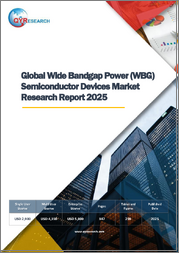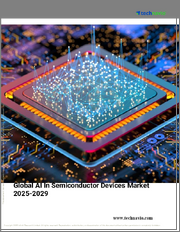
|
시장보고서
상품코드
1609816
일본의 반도체 디바이스 시장 보고서 : 디바이스 유형별, 최종 용도 분야별, 지역별(2025-2033년)Japan Semiconductor Device Market Report by Device Type, End Use Vertical (Automotive, Communication, Consumer Electronics, Industrial, Computing/Data Storage, and Others), and Region 2025-2033 |
||||||
일본의 반도체 디바이스 시장의 시장 규모는 2024년에 386억 달러에 달했습니다. 향후 IMARC Group은 2033년에 597억 달러에 달하며, 2025-2033년의 성장률(CAGR)은 5%에 달할 것으로 예측하고 있습니다. 스마트 가전, 웨어러블, 커넥티드 센서 등 처리와 접속을 반도체에 의존하는 사물인터넷(IoT) 디바이스의 애플리케이션 증가가 주로 시장을 촉진하고 있습니다.
본 리포트에서 답변하는 주요 질문
- 일본의 반도체 디바이스 시장은 지금까지 어떻게 추이해 왔으며, 향후 어떻게 추이하는가?
- COVID-19가 일본의 반도체 디바이스 시장에 미친 영향은?
- 일본의 반도체 디바이스 시장의 디바이스 유형별 내역은?
- 일본의 반도체 디바이스 시장의 최종 용도 분야별 내역은?
- 일본의 반도체 디바이스 시장의 밸류체인에는 어떤 단계가 있는가?
- 일본의 반도체 디바이스의 주요 촉진요인과 과제는?
- 일본의 반도체 디바이스 시장의 구조와 주요 기업은?
- 일본의 반도체 디바이스 시장에서 경쟁의 정도는?
목차
제1장 서문
제2장 조사 범위와 조사 방법
- 조사의 목적
- 이해관계자
- 데이터 소스
- 시장 추정
- 조사 방법
제3장 개요
제4장 일본의 반도체 디바이스 시장 : 서론
- 개요
- 시장 역학
- 업계 동향
- 경쟁 정보
제5장 일본의 반도체 디바이스 시장 구도
- 과거 및 현재 시장 동향(2019-2024년)
- 시장 예측(2025-2033)
제6장 일본의 반도체 디바이스 시장 : 디바이스 유형별 내역
- 디스크리트 반도체
- 옵토일렉트로닉스
- 센서
- 집적회로
제7장 일본의 반도체 디바이스 시장 : 최종 용도별 내역
- 자동차
- 통신(유선 및 무선)
- 가전
- 산업
- 컴퓨팅/데이터 스토리지
- 기타
제8장 일본의 반도체 디바이스 시장 : 경쟁 구도
- 개요
- 시장 구조
- 시장 기업 포지셔닝
- 주요 성공 전략
- 경쟁 대시보드
- 기업 평가 상한
제9장 주요 기업의 개요
제10장 일본의 반도체 디바이스 시장 - 업계 분석
- 촉진요인·억제요인·기회
- Porter's Five Forces 분석
- 밸류체인 분석
제11장 부록
KSA 24.12.24Japan semiconductor device market size reached USD 38.6 Billion in 2024. Looking forward, IMARC Group expects the market to reach USD 59.7 Billion by 2033, exhibiting a growth rate (CAGR) of 5% during 2025-2033. The increasing application of Internet of Things (IoT) devices, such as smart appliances, wearables, and connected sensors, which rely on semiconductors for processing and connectivity, is primarily driving the market.
A semiconductor device is an electronic component made from semiconductor materials, typically silicon, that can control the flow of electrical current. These devices are fundamental to modern electronics and serve various functions in electronic circuits. Semiconductor devices can be categorized into two types: diodes and transistors. Diodes allow the current flow in one direction and are used in rectification and signal-clamping applications. Transistors, on the other hand, are the building blocks of digital circuits and amplifiers. They can amplify or switch electronic signals and come in various types, such as bipolar junction transistors (BJTs) and field-effect transistors (FETs). Semiconductor device are crucial components in a wide range of electronic devices, including computers, smartphones, televisions, and automotive systems. They enable the processing and control of electrical signals, making them essential for data processing, communication, and power management. Advances in semiconductor technology have led to more powerful, smaller, and energy-efficient devices, revolutionizing the electronics industry and shaping the modern technological landscape.
Japan Semiconductor Device Market Trends:
The semiconductor device market in Japan is poised for continuous growth, primarily driven by several interconnected factors. Firstly, the proliferation of consumer electronics and the Internet of Things (IoT) has surged demand for smaller, more efficient, and power-saving semiconductor components. Additionally, the ever-evolving 5G technology landscape requires advanced semiconductor solutions to enable faster data transfer and lower latency, contributing significantly to market expansion. Furthermore, the automotive industry's push toward electric and autonomous vehicles has spurred innovation in semiconductor technology, with a focus on sensors, power management, and advanced microcontrollers. This trend is closely connected to the increasing demand for electric vehicles, which rely heavily on sophisticated semiconductor devices for battery management and vehicle control systems. Moreover, the ongoing digital transformation across industries, including healthcare, industrial automation, and smart cities, which necessitate cutting-edge semiconductor solutions to enable efficient data processing and connectivity, is expected to drive the market in Japan during the forecast period.
Japan Semiconductor Device Market Segmentation:
Device Type Insights:
- Discrete Semiconductors
- Optoelectronics
- Sensors
- Integrated Circuits
- Analog
- Logic
- Memory
- Micro
End Use Vertical Insights:
- Automotive
- Communication (Wired and Wireless)
- Consumer Electronics
- Industrial
- Computing/Data Storage
- Others
Competitive Landscape:
The market research report has also provided a comprehensive analysis of the competitive landscape in the market. Competitive analysis such as market structure, key player positioning, top winning strategies, competitive dashboard, and company evaluation quadrant has been covered in the report. Also, detailed profiles of all major companies have been provided.
Key Questions Answered in This Report:
- How has the Japan semiconductor device market performed so far and how will it perform in the coming years?
- What has been the impact of COVID-19 on the Japan semiconductor device market?
- What is the breakup of the Japan semiconductor device market on the basis of device type?
- What is the breakup of the Japan semiconductor device market on the basis of end use vertical?
- What are the various stages in the value chain of the Japan semiconductor device market?
- What are the key driving factors and challenges in the Japan semiconductor device?
- What is the structure of the Japan semiconductor device market and who are the key players?
- What is the degree of competition in the Japan semiconductor device market?
Table of Contents
1 Preface
2 Scope and Methodology
- 2.1 Objectives of the Study
- 2.2 Stakeholders
- 2.3 Data Sources
- 2.3.1 Primary Sources
- 2.3.2 Secondary Sources
- 2.4 Market Estimation
- 2.4.1 Bottom-Up Approach
- 2.4.2 Top-Down Approach
- 2.5 Forecasting Methodology
3 Executive Summary
4 Japan Semiconductor Device Market - Introduction
- 4.1 Overview
- 4.2 Market Dynamics
- 4.3 Industry Trends
- 4.4 Competitive Intelligence
5 Japan Semiconductor Device Market Landscape
- 5.1 Historical and Current Market Trends (2019-2024)
- 5.2 Market Forecast (2025-2033)
6 Japan Semiconductor Device Market - Breakup by Device Type
- 6.1 Discrete Semiconductors
- 6.1.1 Overview
- 6.1.2 Historical and Current Market Trends (2019-2024)
- 6.1.3 Market Forecast (2025-2033)
- 6.2 Optoelectronics
- 6.2.1 Overview
- 6.2.2 Historical and Current Market Trends (2019-2024)
- 6.2.3 Market Forecast (2025-2033)
- 6.3 Sensors
- 6.3.1 Overview
- 6.3.2 Historical and Current Market Trends (2019-2024)
- 6.3.3 Market Forecast (2025-2033)
- 6.4 Integrated Circuits
- 6.4.1 Overview
- 6.4.2 Historical and Current Market Trends (2019-2024)
- 6.4.3 Market Segmentation
- 6.4.3.1 Analog
- 6.4.3.2 Logic
- 6.4.3.3 Memory
- 6.4.3.4 Micro
- 6.4.4 Market Forecast (2025-2033)
7 Japan Semiconductor Device Market - Breakup by End Use Vertical
- 7.1 Automotive
- 7.1.1 Overview
- 7.1.2 Historical and Current Market Trends (2019-2024)
- 7.1.3 Market Forecast (2025-2033)
- 7.2 Communication (Wired and Wireless)
- 7.2.1 Overview
- 7.2.2 Historical and Current Market Trends (2019-2024)
- 7.2.3 Market Forecast (2025-2033)
- 7.3 Consumer Electronics
- 7.3.1 Overview
- 7.3.2 Historical and Current Market Trends (2019-2024)
- 7.3.3 Market Forecast (2025-2033)
- 7.4 Industrial
- 7.4.1 Overview
- 7.4.2 Historical and Current Market Trends (2019-2024)
- 7.4.3 Market Forecast (2025-2033)
- 7.5 Computing/Data Storage
- 7.5.1 Overview
- 7.5.2 Historical and Current Market Trends (2019-2024)
- 7.5.3 Market Forecast (2025-2033)
- 7.6 Others
- 7.6.1 Historical and Current Market Trends (2019-2024)
- 7.6.2 Market Forecast (2025-2033)
8 Japan Semiconductor Device Market - Competitive Landscape
- 8.1 Overview
- 8.2 Market Structure
- 8.3 Market Player Positioning
- 8.4 Top Winning Strategies
- 8.5 Competitive Dashboard
- 8.6 Company Evaluation Quadrant
9 Profiles of Key Players
- 9.1 Company A
- 9.1.1 Business Overview
- 9.1.2 Product Portfolio
- 9.1.3 Business Strategies
- 9.1.4 SWOT Analysis
- 9.1.5 Major News and Events
- 9.2 Company B
- 9.2.1 Business Overview
- 9.2.2 Product Portfolio
- 9.2.3 Business Strategies
- 9.2.4 SWOT Analysis
- 9.2.5 Major News and Events
- 9.3 Company C
- 9.3.1 Business Overview
- 9.3.2 Product Portfolio
- 9.3.3 Business Strategies
- 9.3.4 SWOT Analysis
- 9.3.5 Major News and Events
- 9.4 Company D
- 9.4.1 Business Overview
- 9.4.2 Product Portfolio
- 9.4.3 Business Strategies
- 9.4.4 SWOT Analysis
- 9.4.5 Major News and Events
- 9.5 Company E
- 9.5.1 Business Overview
- 9.5.2 Product Portfolio
- 9.5.3 Business Strategies
- 9.5.4 SWOT Analysis
- 9.5.5 Major News and Events
10 Japan Semiconductor Device Market - Industry Analysis
- 10.1 Drivers, Restraints, and Opportunities
- 10.1.1 Overview
- 10.1.2 Drivers
- 10.1.3 Restraints
- 10.1.4 Opportunities
- 10.2 Porters Five Forces Analysis
- 10.2.1 Overview
- 10.2.2 Bargaining Power of Buyers
- 10.2.3 Bargaining Power of Suppliers
- 10.2.4 Degree of Competition
- 10.2.5 Threat of New Entrants
- 10.2.6 Threat of Substitutes
- 10.3 Value Chain Analysis



















